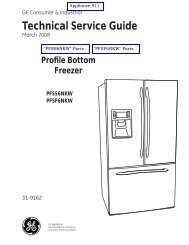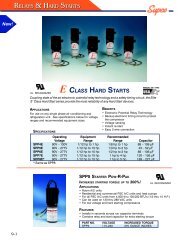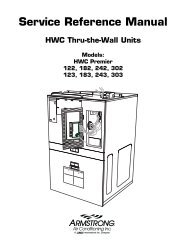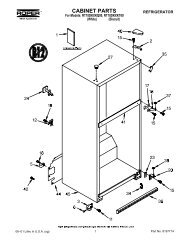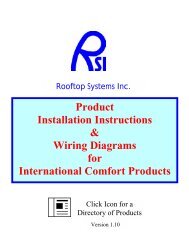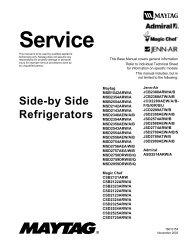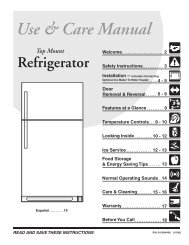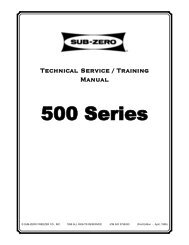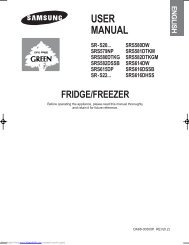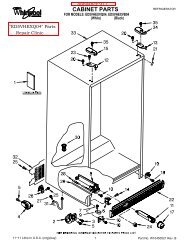ASD2620HE Amana Refrigerator Service Manual - Appliance 911 ...
ASD2620HE Amana Refrigerator Service Manual - Appliance 911 ...
ASD2620HE Amana Refrigerator Service Manual - Appliance 911 ...
You also want an ePaper? Increase the reach of your titles
YUMPU automatically turns print PDFs into web optimized ePapers that Google loves.
Component Testing<br />
! WARNING<br />
To avoid risk of electrical shock, personal injury, or death, disconnect electrical power source to unit, unless test<br />
procedures require power to be connected. Discharge capacitor through a resistor before attempting to service.<br />
Ensure all ground wires are connected before certifying unit as repaired and/or operational.<br />
Water valve<br />
Description Test Procedures<br />
Controls water flow to the ice maker. Check resistance across coil windings.<br />
Controlled by thermostat in ice maker.<br />
See Ice Maker Section for further<br />
information.<br />
Evaporator Inner volume of evaporator allows liquid<br />
refrigerant discharged from capillary to<br />
expand into refrigerant gas.<br />
Evaporator defrost<br />
heater<br />
Thermostat<br />
Thermistor<br />
Expansion cools evaporator tube and fin<br />
temperature to approximately -20°F<br />
transferring heat from freezer section to<br />
refrigerant.<br />
Passing through suction line to<br />
compressor, the refrigerant picks up<br />
superheat (a relationship between<br />
pressure and temperature that assures<br />
complete vaporization of liquid<br />
refrigerant) as the result of capillary tube<br />
soldered to suction line.<br />
Refrigerant gas is pulled through suction<br />
line by compressor, completing<br />
refrigeration cycle.<br />
Activated when defrost thermostat,<br />
defrost timer, and freezer control<br />
complete circuit through heater.<br />
Thermostat is in a series circuit with<br />
terminal 2 of defrost timer, and defrost<br />
heater. Circuit is complete if evaporator<br />
fan motor operates when cold.<br />
Controls the circuit from freezer<br />
thermostat through defrost terminator to<br />
defrost heater. Opens and breaks circuit<br />
when thermostat senses preset high<br />
temperature.<br />
Test for leaks in evaporator with electronic leak detector or with soap solution.<br />
Compressor oil is circulated with refrigerant; check for oil when checking for<br />
leaks.<br />
For minute leaks<br />
1. Separate evaporator from rest of refrigeration system and pressurize<br />
evaporator up to a maximum of 140 PSI with a refrigerant and dry nitrogen<br />
combination.<br />
2. Recheck for leaks.<br />
Check resistance across heater.<br />
Temperature sensing device Check resistance across leads.<br />
To check defrost system :<br />
1. Thermocouple defrost thermostat and plug refrigerator into wattmeter.<br />
2. Turn into defrost mode. Wattmeter should read specified watts (according to<br />
Technical Data Sheet).<br />
3. When defrost thermostat reaches specified temperature ±5°F (see Technical<br />
Data Sheet), thermostat should interrupt power to heater.<br />
Test continuity across terminals.<br />
With power off and evaporator coil below freezing, thermostat should show<br />
continuity when checked with ohmmeter. See “Heater, evaporator (defrost)”<br />
section for additional tests.<br />
After defrost thermostat opens, thermostat remains open until end of defrost cycle<br />
and refrigerator starts cooling again. Defrost thermostat senses a preset low<br />
temperature and resets (closes).<br />
Temperature Resistance<br />
77°F 10,000 ohms<br />
36°F 29,500 ohms<br />
0°F 86,300 ohms<br />
WARNING<br />
©2005 Maytag <strong>Service</strong>s 16025628 9<br />
!<br />
To avoid severe personal injury or death from sudden erruption of<br />
high pressurres gases, observe the following:<br />
• Protect against a sudden eruption if high pressures are required<br />
for leak checking.<br />
• Do not use high pressure compressed gases in refrigeration<br />
systems without a reliable pressure regulator and pressure relief<br />
valve in the lines.




